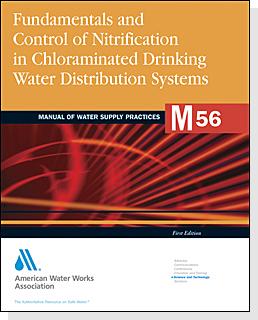The AWWA Distribution System Water Quality Committee is embarking on revisions to their M56: Fundamentals and Control of Nitrification in Chloraminated Drinking Water Distribution Systems. The M56 manual is a complete guide to managing nitrification and is intended to be a principal technical resource for water system operators throughout the US.
embarking on revisions to their M56: Fundamentals and Control of Nitrification in Chloraminated Drinking Water Distribution Systems. The M56 manual is a complete guide to managing nitrification and is intended to be a principal technical resource for water system operators throughout the US.
Manual 56 does discuss operational and treatment practices to prevent nitrification and specifically discusses several strategies. Increasing turn-over is one option discussed, but the manual acknowledges that this may be insufficient to eliminate stratification. The use of recirculation pumps is also discussed. However in neither case is the energy expense of these options mentioned: both can consume a surprising amount of electricity.
Manual 56 does discuss mixing, albeit briefly. At the time this section of the manual was written, the only mixing technology that was on the market consisted of passive nozzles or separated inlets and outlets.
We now know that passive systems often fail to adequately mix tanks. We at PAX have already encountered several customers who installed passive systems (often at great expense) to reduce nitrification risk in a reservoir, only to find that nitrification problems persisted. Furthermore, passive systems require certain levels of daily turn-over to work, and this often locks operators into using their pumps more than they otherwise would.
Mixing technology has changed a great deal since M56 was last updated. Today, small active mixing systems such as the PAX Mixer have been shown to completely eliminate thermal stratification in even the largest tanks and reservoirs, and have been shown to reliably operate year after year.
Active mixing reduces the risk of nitrification in several ways.
First – active mixing eliminates dead spots where water can lose it’s residual disinfectant. By circulating fresh disinfectant throughout a tank, active mixing helps to keep biofilms at bay and reduce overall residual demand (see the Opflow article on Old Town, Maine for an example of this).
Second – active mixing lowers the temperature of water in the top of the tank. It is this top water that is the most prone to lose disinfectant residual and be the starting place for nitrification. By actively circulating the water, surface temperatures drop and the rate of any biological activity decreases.
Third – active mixing can prevent the runaway effect of nitrification from starting. In the case of one chloraminated tank in Redwood City, CA, (see our case study) our mixer was installed and turned on right as nitrite levels were beginning to climb in the top water of the tank (Figure 1). Once the circulation began, nitrite levels dropped back down to low levels and remained there.
We have now installed PAX mixers in more than 60 tanks where nitrification was identified as the principal concern for the operator. Our results so far clearly show that active mixing is an effective and economical tool for improving tank hydraulics, eliminating stratification, and reducing nitrification risk.
We appreciate your comments and questions.
Sincerely,
Peter S. Fiske, Ph.D.
CEO, PAX Water Technologies
